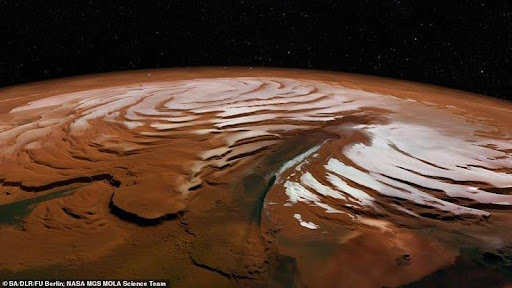
WORMHOLES:COSMIC SHORTCUTS
What if you could rocket from Earth, not to the Moon or Mars, but down a wormhole that loops all the way across the vast Milky Way, slashing travel time
Mars or the Red Planet has been inspiring scientists and other people for several hundreds of years, and the recent findings do the same. The most recent achievement in Mars exploration is that researchers have found large quantities of ice mixed with water on the Martian surface. This discovery doesn’t just benefit the study of Mars but helps bring the dream of the human colony one step closer. This blog goes further to discuss the consequences of the discovery, the entire process of how the discovery was made and the significance of the discovery to future missions to Mars.
The Discovery: ‘’A Game Changer’’
The discovery of substantial water blown into Mars was made known in the later part of 2023 when researchers identified from data obtained from the MRO and Mars Express that ice water existed on Mars. This information was collected by radar sounders which are capable of ‘seeing’ beneath the Martian crust. These results illustrate that there is ice water at rather a small depth in different areas of the Earth, more specifically mid latitude areas.
These findings cannot be overemphasized due to their implication for understanding the world and people’s lives. H2O is a vital component that is indispensable for the existence of life as we know it, thus, its detection on Mars increases the probability of presence of microbial life on the surface of the red planet. Also for human explorers and settlers water with ice is a very valuable source of water for drinking purposes, and for creation of waterways for growing of food plants and crops as well as production of fuel.
How the Discovery of Penicillin Occurred?
The radar sounders that are present on the Mars Reconnaissance Orbiter and the Mars Express function on the same principle where a radio wave is transmitted towards the surface of the planet. When any of these waves interact with a material that has a different electrical properties from that of the orbiter material as is the case of ice they are reflected back towards the orbiter. Through arrivals of these waves’ time and strength amplitudes, it is possible for scientists to recognize the depth levels and contents of subsurface materials.
They have used radar sounders to detect the reflected signal regarding the evidence of a large amount of ice water that is about several meters below the Martian surface. Thus, In regards to the latter, it is assumed that the ice contains some amount of dust and rocks that have solidified into a stable layer and remained undisturbed for millennia.
Implications for Human Exploration
The fact of ice water on Mars is exciting for the future of people’s space travel and colonization. Here are a few key points:Here are a few key points:
Sustainable Water Supply: Water is dense, and it is very expensive to transport from the earth. An on site of water on Mars also implies that future missions to the red planet would not need to transport water from Earth which is less costly and cumbersome.
Agriculture and Food Production: Water is a primary requirement for growing crops and hence the availability of water to farmers to irrigate their crops cannot be overemphasized. Hence, the ability to cultivate plants on Mars by using the planet’s water will be a significant boon for the long-term human missions and inhabited quarters on the Red Planet, as it will DIY the astronauts’ food production.
Fuel Production: During the process of electrolysis, water can be split into element hydrogen and element oxygen. The gas which can be used for fuel is hydrogen and the gas needed for respiration is oxygen. This process could provide a renewable source of both fuel and life support which in turn could support longer mission duration and reliance on earth based resources. 
Scientific Research: The availability of ice water also creates new areas of investigation. It can be understood from the ice regarding the climate history and existence of life on Mars as it enables climate studies. There may also be gasses and other things frozen in ice which should help scientists decipher the processes that occur on the planet.
Challenges and Considerations
Thus, although discovering ice water is thrilling, it is also accompanied by certain difficulties. To harvest and implement this resource on Mars, one will have to make use of sophisticated tools and systems. Here are some considerations:
Extraction Technology: Improving the ways and means through which water can be separated from it is very important. This may include a process of carving a hole through it, melting the ice and filtering it to make the water suitable for consumption.
Environmental Impact: Exploration and utilization of water on Mars and any other activities that humans may undertake on the planet needs to adhere to the necessary measures that will help avoid having negative impacts on the environment of planet Mars. This includes avoiding pollution of potential abodes of Martian life.
Radiation Protection: The planet Mars has very poor protection from radiation because it has a very thin atmosphere, and no magnetic field like Earth has. Any habitat or any water extraction facility will have to be protected from this kind of radiation to avoid harm on equipment or health of any individual.
Logistics and Infrastructure: Developing facilities to facilitate extraction to and use of the water will not be an easy task. This includes transportation and energy storage and supply.
Looking Ahead: The Future of Mars Exploration.
The finding of ice water on Mars is a historic achievement that is nurturing humanity’s dream of being a space-faring civilization. It clears the path to further complex missions such as the sending of human and other forms of life and colonization of Mars. Companies such as NASA, SpaceX, and other space-related agencies as well as private entities are already considering expeditions that will make use of this resource.
Looking into the future, one will be able to predict robotic missions, which will study and describe these ice deposits in more detail. These missions will probably establish the experiment of new technology of water extraction and its use, preparation for manned missions for the 30s and further.
Ice water discovered on Mars does not only improve the chances of manned missions but also sparks up our creativity and interest. It tells the generations of the numerous opportunities that are available within the realm of space exploration despite the many hardships that need to be endured. With exploring space emerging as the next big frontier, the finding of ice water on Mars is the discovery of hope for the future of mankind in the universe.

What if you could rocket from Earth, not to the Moon or Mars, but down a wormhole that loops all the way across the vast Milky Way, slashing travel time

If you go outdoors on a clear evening and also search for it, you might have the ability to see Jupiter beaming brilliantly amongst the celebrities. At the exact same

Stars, the dazzling points of light that fill up the evening skies are the foundation of galaxies plus the cradles of life itself. From their birth in large clouds of

In the mission to recognize deep space mankind has actually developed progressively effective devices to observe deep space. Completion of this venture is the Extremely Large Telescope (ELT) which is

Space debris, also known as space junk, refers to the defunct artificial objects orbiting Earth. These objects include decommissioned satellites, spent rocket stages, and fragments from collisions and explosions.

The search for exoplanets– planets that orbit stars outside our planetary system– has actually quickly developed into one of the most interesting and dynamic fields of astronomy
Write to
Jasmine Gogoi at csr@scientifictemperament.com
Let’s develop our society with a scientific heart. Join us to build the scientifically nurtured future →